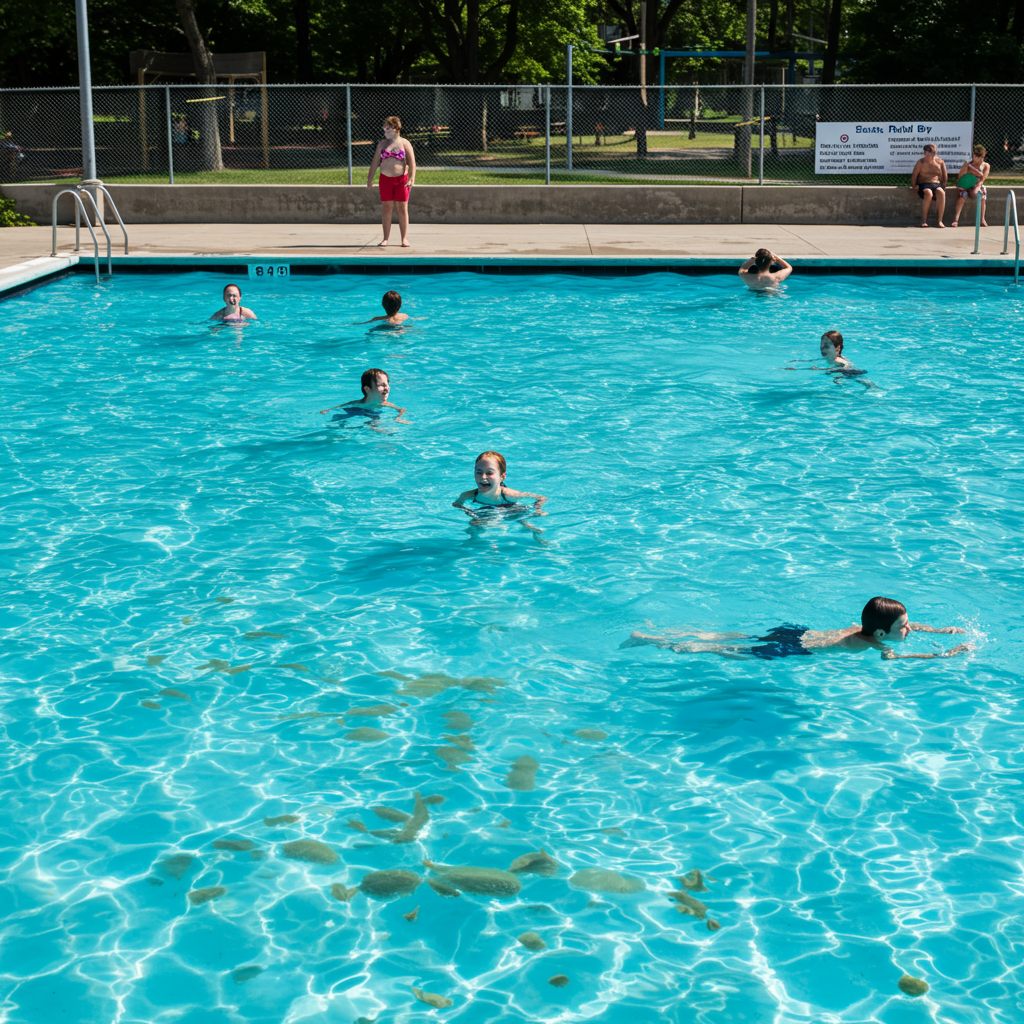For many, the inviting sparkle of a public swimming pool represents refreshing escape and healthy activity. Swimming offers significant benefits, providing a complete body workout that’s gentle on joints while boosting cardiovascular health. It’s one of humanity’s most enduring pastimes, with precursors dating back millennia. Yet, alongside the benefits, a common question lingers: how clean are these shared waters, really?
Unfortunately, even in seemingly well-maintained pools, various microorganisms and chemical reactions can turn pristine water into a potential source of infection if proper protocols aren’t followed. Understanding what might be present and how pools are managed is key to enjoying a safe swim.
Unmasking the Unseen: Common Pool Contaminants
While modern pools utilize disinfection methods, a surprising array of organisms can sometimes survive the process. These can include bacteria, viruses, fungi, and even parasites. Data indicates that swimming pools have historically been a common setting for waterborne illness outbreaks in certain regions.
The Persistent Parasite Threat
One of the most notorious pool residents is Cryptosporidium, a parasite known for causing crypto, a nasty stomach bug. Symptoms typically include diarrhea, vomiting, and abdominal pain, sometimes lasting up to two weeks with potential relapses. While generally clearing up in healthy individuals, crypto poses a higher risk for young children, the elderly, and those with weakened immune systems.
Cryptosporidium is particularly problematic because it’s remarkably resistant to standard chlorine levels. Experts note that while chlorine kills most pathogens in minutes, crypto can remain viable for over a week. This resilience is due to its protective spore structure, which prevents disinfectants from reaching its interior.
Alarmingly, studies show parasitic contamination can be widespread. A 2023 study assessing swimming pools in Alexandria, Egypt, found a staggering 73.1% of water samples contained parasites. The most common were intestinal coccidia like Cyclospora and Isospora (each in 37.2% of samples), followed closely by Cryptosporidium (34.6%). Other detected parasites included Giardia lamblia, Microsporidia, Blastocystis, and Acanthamoeba. The presence of Acanthamoeba is concerning, as this group of parasites can cause serious, potentially blinding eye infections.
Transmission of these parasites often occurs when infected individuals have fecal accidents in the pool or shed microscopic fecal matter from their bodies, which swimmers then ingest, even in tiny amounts. Research suggests that even when actively trying to avoid swallowing water, people, especially children, still ingest measurable volumes.
Bacterial and Viral Intruders
Parasites aren’t the only concern. Opportunistic bacteria like Staphylococcus can cause skin infections. Humid, shared environments like changing rooms are also breeding grounds for fungal infections. Beyond skin issues, other bacteria can cause gastrointestinal illness. While thankfully much of this risk is mitigated by chlorine, bacteria like Campylobacter, Shigella, and Salmonella can lead to diarrhea, cramps, and fever.
Swimmer’s ear, usually caused by water lingering in the ear canal, is another common bacterial issue, though not typically spread person-to-person in the pool itself. More seriously, Legionella bacteria, though uncommon, can be inhaled in water droplets and cause Legionnaires’ disease, a severe lung infection.
Viruses like norovirus, known for causing vomiting and diarrhea, are tougher than many bacteria but generally killed by adequate chlorine levels. Outbreaks linked to pools are usually associated with equipment failure or insufficient chlorine. Other viruses potentially spread in shared recreational water or associated facilities include those causing conditions like plantar warts, molluscum contagiosum, and even certain types of herpes, often through direct contact or contaminated surfaces.
The Invisible Chemistry: Beyond the Microbes
It might surprise you that the distinct “chlorine smell” often associated with swimming pools isn’t the scent of pure chlorine itself. This odor is actually caused by chloramines, chemical compounds formed when chlorine reacts with organic matter like urine, sweat, and fecal material introduced by swimmers.
The presence of chloramines indicates that contaminants are reacting with the disinfectant. These chemicals hover just above the water surface and can irritate the eyes, skin, and respiratory tract. Some research suggests continuous exposure to high chloramine levels, particularly for pool staff, might be linked to an increased risk of developing asthma.
The Source of Contamination: It’s About People
Microbes and organic matter don’t appear in the water spontaneously; they are overwhelmingly introduced by swimmers. Fecal accidents, though obvious and requiring immediate response, are just one source. Passive shedding of microscopic fecal particles also occurs. Sweat, urine, skin cells carrying bacteria (like Staph) and fungi (like those causing athlete’s foot or ringworm), and other bodily fluids contribute to the pool’s contaminant load. Items like towels or footwear that pick up germs in locker rooms can also indirectly transfer pathogens.
The Alexandria study found that higher parasitic contamination was linked to factors like heavy daily bather load, higher water temperatures, longer pool work durations, and longer turnover times (how long it takes to filter all the water). Cleaning frequency, water flow rate, and even high levels of residual chlorine (above standard) and Total Dissolved Solids (TDS) were also associated with increased risk, suggesting that complex factors, including pool management and the water’s chemical balance, impact hygiene beyond simple chlorination.
Maintaining Safety: The Role of Chemistry and Practice
Effective swimming pool hygiene is a science. It relies on maintaining the right chemical balance, primarily the proper levels of disinfectant (like chlorine) and pH. The water’s pH and alkalinity must be within specific ranges for chlorine to work effectively. The amount of chlorine needed also fluctuates based on how many people are in the pool – higher bather loads create greater demand for disinfectant.
While regulation of public pools varies by country (voluntary CDC guidelines in the US, Health and Safety at Work Act in the UK), consistent monitoring and maintenance are critical. Even with good practices, as noted, some pathogens like Cryptosporidium are resistant.
Mitigating the risk of chlorine-resistant pathogens or significant contamination events requires prompt action. This might involve using special filtration methods or “super chlorination” – temporarily adding much higher levels of chlorine and restricting pool access.
Taking Action: Swimmer and Operator Responsibilities
Ensuring a safe swimming experience is a shared responsibility. Swimmers play a crucial role in preventing contamination.
Tips for Swimmers:
Shower Thoroughly BEFORE Swimming: This is perhaps the single most effective step. Showering with soap and water washes away most dirt, sweat, and potential fecal residue before you enter the pool, dramatically reducing the contaminants added to the water.
Avoid Swallowing Pool Water: The primary way gastrointestinal pathogens spread is by ingesting contaminated water.
Never Swim When Sick: Especially if experiencing diarrhea. Do not swim until at least 24 hours after symptoms have resolved.
Report Accidents Immediately: Alert pool staff to any fecal accidents so they can address them quickly. Exit the pool if an accident occurs nearby.
Practice Good Personal Hygiene: Wash hands thoroughly after using the restroom or changing diapers. Avoid scratching or entering the pool with open wounds or skin infections. Consider wearing water shoes in locker rooms and shower areas to prevent fungal infections like athlete’s foot and viral infections like plantar warts.
Shower AFTER Swimming: Rinse off pool water and potential contaminants.
Tips for Pool Operators (Based on best practices and study findings):
Maintain Strict Chemical Balance: Regularly monitor and adjust chlorine and pH levels to ensure optimal disinfection. Understand how bather load impacts chlorine demand.
Ensure Effective Filtration: Proper filtration systems and flow rates are essential for removing particles, including resistant cysts.
Respond Swiftly to Contamination: Have clear protocols for dealing with fecal accidents, including potential super chlorination or temporary closure if necessary.
Prioritize Cleaning: Regularly clean pool surfaces to prevent slime and biofilm buildup. Clean and disinfect changing rooms, showers, and locker areas frequently.
Ensure Good Ventilation: Adequate ventilation helps dissipate chloramines accumulating above the water surface.
Educate Swimmers: Clearly post rules about showering before swimming, not swimming when sick, and using the restroom.
Balancing the Benefits and Risks
Despite the potential for contamination, experts largely agree that the extensive health and social benefits of swimming outweigh the risks, provided pools are properly maintained and swimmers follow good hygiene practices. Properly operated pools with diligent staff who know how to manage water chemistry and respond to incidents pose minimal infectious disease risk.
So, as you head to the pool, remember that a safe swim starts before you even dip your toe in the water. A quick rinse in the shower is your first line of defense for yourself and fellow swimmers.
Frequently Asked Questions
Why are some germs, like Cryptosporidium, harder to kill in pool water?
Certain pathogens, notably the parasite Cryptosporidium, have protective structures. Cryptosporidium forms a tough spore that is highly tolerant to typical chlorine levels. While chlorine kills most bacteria and viruses quickly, crypto spores can survive for over a week in regularly chlorinated water, making them a persistent risk if introduced into the pool.
Besides swallowing water, how else can you get sick from swimming pools?
You can contract infections through skin contact, inhalation, or contact with contaminated surfaces. Skin infections like Staph, folliculitis, ringworm, or impetigo can spread through shared surfaces or direct contact. Swimmer’s ear results from water trapped in the ear canal. Inhaling water droplets containing bacteria like Legionella can cause respiratory illness. Walking barefoot in wet areas can lead to fungal infections (athlete’s foot, jock itch) or viral warts.
What can swimmers and pool operators do to improve swimming pool hygiene?
Swimmers should shower with soap and water before entering the pool, avoid swimming when sick (especially with diarrhea), avoid swallowing water, and use the restroom. Operators must diligently monitor and maintain proper water chemistry (chlorine, pH), ensure effective filtration, clean facilities regularly, and have clear procedures for responding to contamination events like fecal accidents, including potential super chlorination.




